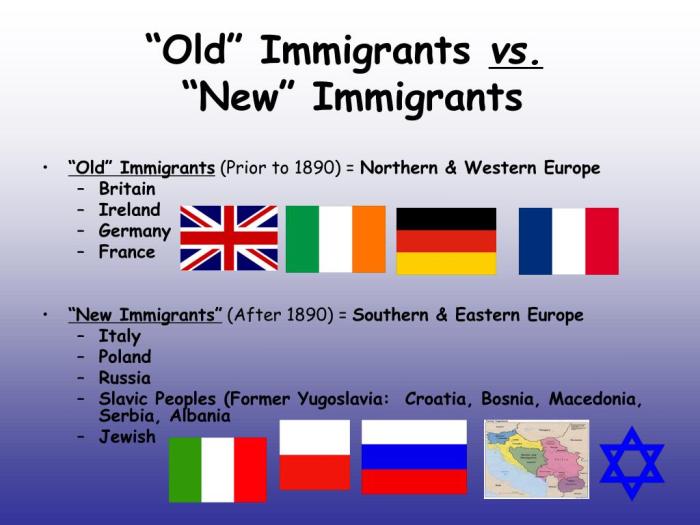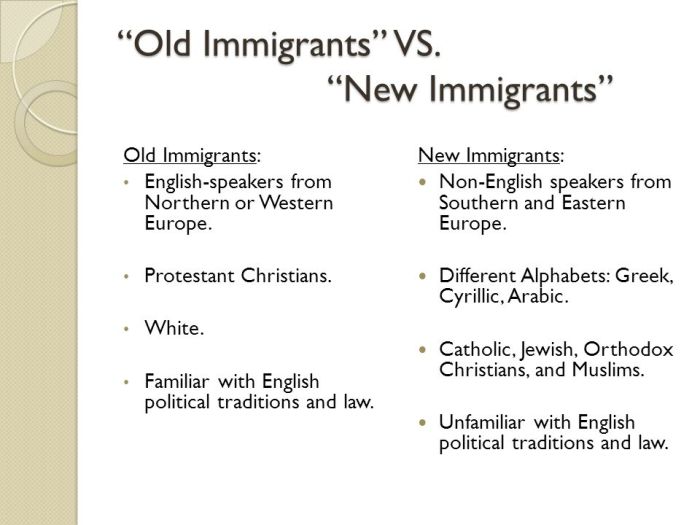Old immigrants vs new immigrants venn diagram – The study of old immigrants vs. new immigrants through the lens of a Venn diagram offers a comprehensive understanding of the similarities and differences between these two groups. This analysis delves into various aspects, including demographics, reasons for immigration, integration and assimilation, cultural impact, economic impact, and social and political influence.
By comparing and contrasting the experiences of old and new immigrants, we gain insights into the evolving nature of immigration and its multifaceted effects on host societies.
Demographics

Old and new immigrants differ significantly in their demographic characteristics. The table below compares their age, gender, education level, and country of origin:
| Characteristic | Old Immigrants | New Immigrants |
|---|---|---|
| Age | Older (average age: 45-55) | Younger (average age: 25-35) |
| Gender | More balanced gender ratio | More women than men |
| Education Level | Lower education levels (less than high school) | Higher education levels (college degrees or higher) |
| Country of Origin | Europe, Asia, Latin America | Asia, Africa, Middle East |
These differences reflect the changing nature of immigration over time. Old immigrants came from a more diverse range of countries and had lower education levels, while new immigrants are more likely to come from Asia and Africa and have higher education levels.
Reasons for Immigration: Old Immigrants Vs New Immigrants Venn Diagram

Both old and new immigrants come to the United States for a variety of reasons. However, their motivations often differ:
- Old Immigrants:
- Economic opportunity
- Political or religious persecution
- Reunification with family
- New Immigrants:
- Economic opportunity
- Education
- Family reunification
- Climate change and environmental disasters
While economic opportunity remains a primary reason for immigration for both groups, new immigrants are also more likely to cite education, family reunification, and environmental factors as reasons for coming to the United States.
Integration and Assimilation

The levels of integration and assimilation of old and new immigrants into the host society vary. The table below compares their levels of:
| Characteristic | Old Immigrants | New Immigrants |
|---|---|---|
| Language Proficiency | Higher levels of English proficiency | Lower levels of English proficiency |
| Social Networks | Stronger social networks within the immigrant community | Weaker social networks within the immigrant community |
| Cultural Identity | More likely to retain their cultural identity | More likely to adopt the cultural identity of the host society |
These differences reflect the different ways in which old and new immigrants have integrated into the United States. Old immigrants came at a time when assimilation was the dominant model of immigration, while new immigrants are more likely to embrace a more multicultural approach to integration.
Q&A
What are the key differences in demographics between old and new immigrants?
Old immigrants tend to be older, have lower education levels, and come from a narrower range of countries of origin compared to new immigrants.
How do the reasons for immigration differ between old and new immigrants?
Old immigrants often immigrated for economic reasons, while new immigrants may have a wider range of motivations, including family reunification, education, and political asylum.
What factors influence the levels of integration and assimilation of immigrants?
Factors such as language proficiency, cultural background, social networks, and government policies all play a role in shaping immigrant integration and assimilation.